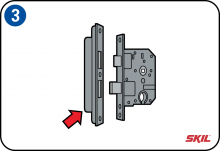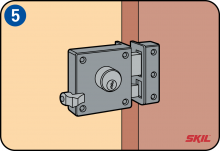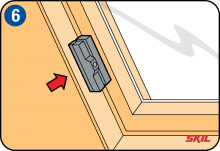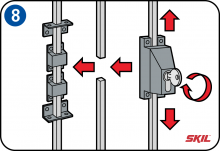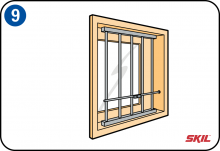-
Your home is a showroom!
Remember that if you leave your curtains or blinds open, it’s easy for a burglar to see exactly what you have in your home. So good burglary prevention starts with where you keep things in your home and your daily routine.
Interior inspection
Make sure there are no items left around the outside of your home which burglars can use to gain access. So don’t leave (step) ladders unlocked in your garden or in an open shed. And the same applies to heavy tools – always keep these locked away. Keep any cellar or basement windows closed, and if necessary fit them with security grilles.
Think like a burglar
Unless you’ve left a door or window open, a burglar starts by forcing a door or window open. Take a good look at all the potential break-in points. For example is it possible to reach the top floor by climbing trees close to the wall, or by using a balcony, waste container, gutter or a trellis for climbing plants? The toilet window is another potential entry point.
Burglars can often gain entry easily using simple tools such as pliers, a screwdriver or crowbar. So make it as hard as possible for them, then they’ll be more likely to try their luck somewhere else. -
Cylinder lock in the outside doors
If you want to replace a simple mortise lock in the door with a more secure cylinder lock, there are a few important points to note:
1. The depth of the lock in the door.
2. The distance between the sprung latch and the locking bolt; this is normally 110 or 72 mm
3. The length of the cylinder is the same as the thickness of the door; this is normally 60 mm
If the door already has a cylinder lock, the locking bolt or night latch must protrude by at least 20 mm. It’s easiest to replace the lock if the body of the lock and the strike plate are the same size as those of the old lock. If that isn’t possible, then choose a lock with a larger faceplate so the new fixing screws will fit into the wood of the door at different points. Or you can fit an additional security bolt to the door. -
Enclosed box keep
If you fit a lock with an enclosed box keep instead of a simple strike plate, a burglar can’t use a screwdriver to push back the locking bolt or night latch. To fit a box keep, you have to cut out or drill out a large enough recess in the door frame for the box section to fit into.
-
Fitting anti-burglary pins
Anti-burglary pins prevent a burglar from simply taking the door out after removing the hinge pin.
Drill a hole with a diameter of 10 mm and a depth of 30 mm in the door about 5 cm from each hinge. Insert the anti-burglary pins into the holes with the pointed ends protruding from the door.
Now press the door closed so that the protruding pins mark out the points on the door frame where the holes for the sleeves have to be drilled. Drill these holes with a diameter of 17 mm and a depth of 20 mm.
You can now insert the sleeves into these holes. You can fit 3 anti-burglary pins in each door. -
Extra lock
If you want to make an outside door extra secure, you can fit a secondary lock at the bottom of the door. Fit this secondary lock in exactly the same way as the main lock in the middle of the door. If there isn’t enough space for this kind of lock, you can still fit a rim lock which is mounted on the inside surface of the door.
-
Sliding doors or windows
If you have sliding doors or windows, you can fit them with cylinder locks. These locks have a pin which protrudes into the sliding part of the door or window. The cylinder lock is operated by a key, and when it’s locked the door or window can’t be opened.
This system can also be used on roof windows and skylights such as Velux windows. Many people forget about these windows. If a burglar can get onto the roof he can then open the locking mechanism inside a skylight using a screwdriver, for example through the ventilation cover. In that case, a cylinder lock with a pin prevents the skylight from being tilted open. -
Increased security with a multipoint lock
A multipoint lock secures the door at 3 different points. The 3 locks are operated by a single key. Fitting is the same as for a single lock, except that the strike plate extends over the entire height of the door.
-
Multipoint rim lock
Multipoint locks are also available in the form of rim locks (surface-mounted locks). These locks have the advantage that they can be fitted to the door without the need for far-reaching changes. The center lock is fitted in the same way as for a single rim lock. The two rods link the central lock with two anchor points: one at the top of the door and one at the bottom. You can saw these rods to the required length and then fit the guides for the rods.
Note that the ends of the rods have to be longer than the door itself, because these have to engage in the strike plates at the top and bottom when the door is closed. First fit the top strike plate in the top part of the door frame. Then if necessary make a recess in the floor to accept the lower rod end. Finally, check that all parts of the rod mechanism operate smoothly. -
Fitting security grilles to basement or cellar windows
You can fit security grilles or bars in front of or behind basement and cellar windows. It’s often possible to buy ready-to-fit security grilles or bars for standard-size window frames, or otherwise you can make them yourself. Divide the width of the window frame into sections of around 20 cm, and mark out the positions of the bars. Make the requires holes (at least 8 cm deep) in the brickwork with a drill or chisel. Check that the bars are securely fitted both vertically and horizontally, and fix them in place with cement.
-
Door viewer
To make sure you don’t open the door to uninvited guests, you can fit a door or ‘peephole’ viewer. This lets you identify callers before you let them in. Drill a hole in the door at around eye height (approximately 1.65 m) with the diameter as indicated on the packaging of the door viewer. Screw the 2 parts of the door viewer containing the optical lenses together as far as possible.
-
Door security latch or chain
Another option that lets you identify callers before opening the door is a door security latch or chain. This allows you to open the door slightly for identification purposes, but prevents the door from being opened fully.
-
Safety foil
If you apply self-adhesive foil, a window won’t break into sharp pieces if it is broken. Cut the foil to size and stick it onto the glass. It’s easier to fit this self adhesive foil if you first moisten the glass with a solution of water and soap. Then you can squeeze out the water under the foil and any remaining air bubbles with a squeegee. Just allow it to dry and that’s it!
-
A fireproof safe
A strongly anchored fireproof safe is a good place to keep all your valuables and important documents safe from fire and theft. It also means you’ll always know where they are, so you won’t have to go looking for them when you need them. Most fireproof safes are fitted with a combination lock.
To fit a fireproof safe you have to select a smart place in your home, for example inside a cupboard. You can easily place the safe on one of the shelves in the cupboard and secure it to the wall at the back. Or for a really professional job, you can fit the safe into a recess in the wall and secure it with cement.



